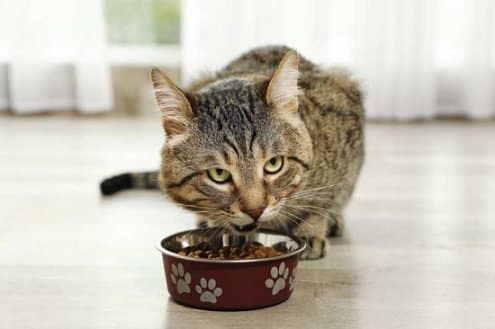Diet shapes day-to-day glucose control in diabetic cats. The best diabetic cat food typically emphasizes high protein, moderate fat, and restricted carbohydrates to help limit post‑meal blood sugar rises. This guide explains how macronutrients, moisture, fiber, and feeding routines work together with insulin therapy. It also outlines budget options, label reading, and when to involve your veterinarian.
Key Takeaways
- Higher protein, lower carbohydrate patterns support steadier glucose.
- Wet foods often provide useful moisture and lower carbs.
- Prescription and non‑prescription options can both be appropriate.
- Match meal timing with insulin and monitor regularly.
- Consult your veterinarian before large diet changes.
Best Diabetic Cat Food
Most diabetic cats benefit from diets that limit non‑fiber carbohydrates while prioritizing animal protein. This macronutrient balance helps reduce the size of post‑prandial glucose swings. Many cats do well on moisture‑rich wet foods, which can support hydration and satiety, though some carefully selected dry foods also fit.
Look for clear protein sources, modest fat, and minimal added sugars or starches. Fiber types matter: soluble fiber may blunt glucose absorption, while insoluble fiber can aid stool quality. Consensus recommendations support these broad patterns in feline diabetes management, though individual needs vary. For summarized clinical guidance, see the AAHA diabetes guidelines (consensus recommendations for cats and dogs).
Wet vs. Dry: Macronutrients and Labels
Wet diets often supply more water and, frequently, fewer digestible carbohydrates per calorie. That combination may help appetite control and hydration, which matters for cats prone to dehydration. Owners seeking the best wet food for diabetic cats should still compare labels carefully, since carbohydrate content varies widely between brands and flavors.
Dry diets can be appropriate if formulated with high protein and reduced starch. Some cats prefer the texture or require dry formats for dental or logistical reasons. In these cases, choose products with measurable carbohydrate limits and consistent batch quality. Work with your veterinarian to pair a suitable dry or mixed plan with insulin timing and home monitoring.
Reading Carbohydrates and Fiber on Labels
Pet food labels in North America do not list carbohydrates directly. You can estimate carbohydrates by difference from the guaranteed analysis (subtract protein, fat, fiber, moisture, and ash). Ask manufacturers for typical analysis on a dry‑matter or energy basis for better comparisons. Prioritize clear animal proteins, and scan for starch sources like corn, rice, potatoes, or peas. Fiber blends differ across products; moderate total fiber with some soluble fraction can help regulate stools and modulate glucose absorption.
Note: Because label formats vary, request nutrient data in comparable units. When in doubt, your veterinary team can help interpret macronutrient targets alongside your cat’s glucose curves and body condition.
Non‑Prescription and Budget Options
Not every diabetic cat requires a prescription label. If your veterinarian agrees, you can select non prescription food for diabetic cats by targeting high protein and lower carbohydrate profiles from mainstream lines. Many over‑the‑counter wet foods meet these criteria, but consistency matters, so confirm typical analysis with the manufacturer when possible.
Budget strategies include rotating cost‑effective flavors with similar macronutrients, buying larger can sizes your cat will finish safely, and avoiding unnecessary treats. Some classic pates are low in starches, while gravy‑heavy options often run higher. Track blood glucose and weight after any switch to confirm the new option supports stable control and adequate nutrition.
Brand Examples and How to Use Them
Several veterinary and commercial brands formulate diets with diabetes in mind. For example, royal canin glycobalance cat food is designed with controlled carbohydrates and specific fiber blends. Manufacturer pages summarize intended nutrient profiles and feeding guidance; review these with your veterinarian. See the Royal Canin information page (product overview and nutrient intent) for typical composition context.
Other common choices include Hill’s m/d and Purina DM, both emphasizing higher protein and limited carbohydrate relative to standard maintenance diets. Actual suitability depends on your cat’s glucose response, stool quality, appetite, and body condition score. If your veterinarian prescribes protamine zinc insulin, for product profile details, see Prozinc Vial as background on insulin pairing considerations. If lente insulin is used, for vial format context, see Caninsulin Vial; for cartridge format details with compatible pens, see Caninsulin Cartridges.
Feeding Routines, Monitoring, and Adjustments
Stable routines support stable glucose. Aim for consistent meal sizes and timing relative to injections. Cats on twice‑daily insulin often eat shortly before or at dosing, though specific timing varies by insulin type and veterinary plan. Owners considering the best diabetic dry cat food should still match calories to need and avoid free‑feeding if it drives weight gain or glucose variability.
Home monitoring improves safety. Track weight, appetite, water intake, and periodic glucose measurements or curves. If you are fine‑tuning dosing around meals, for dose safety guidance and common pitfalls, see Pet Insulin Dosage Mistakes. Proper storage preserves potency; for storage thresholds and handling, see Pet Insulin Storage Tips. Keep a plan for hypoglycemia; for emergency carbohydrate context used under veterinary direction, review Dextrose.
Veterinary guidelines emphasize individualized nutrition and regular reassessment as glycemic control improves. The AAFP feline diabetes guidelines highlight carbohydrate restriction, weight management, and monitoring as cornerstones of care (consensus guidance for cats). Share home data with your veterinarian to adjust meal compositions, frequencies, and insulin doses safely.
Homemade Diets: Pros, Cons, Safety
Home‑prepared diets appeal to owners seeking tight control over ingredients. However, balancing amino acids, minerals, and vitamins is challenging without formal formulation. If you are considering homemade diabetic cat food recipes vet approved, ask a board‑certified veterinary nutritionist to design a complete and safe plan. Nutrient gaps or excesses can destabilize glucose, harm kidneys, or impair heart function.
Partial home cooking can still be useful. Some owners add measured lean meats to a commercial low‑carb base to boost protein without raising starch. Keep total calories consistent and monitor stools and glucose closely after changes. Request dry‑matter or energy‑based nutrient targets from your veterinary team, then evaluate any recipe against those targets before long‑term use.
When to Seek Veterinary Input
Involve your veterinarian before major diet shifts, especially if your cat has pancreatitis, kidney disease, or obesity. These conditions change macronutrient targets and feeding frequencies. Unexpected weight loss, rising thirst, or erratic glucose readings warrant earlier review and possible adjustments.
Bring diet labels, measured daily calories, and recent home glucose data to appointments. This information helps clinicians fine‑tune recommendations quickly. For broader pet care reading organized by topic, see Pet Health for curated articles and background context.
Recap
Feline diabetes management merges nutrition, insulin, and monitoring into a predictable routine. High‑protein, lower‑carbohydrate diets, often wet formats, can help moderate post‑meal glucose. Choose consistent products, align meals with insulin, and track responses. Work with your veterinary team to refine the plan as your cat’s needs change.
This content is for informational purposes only and is not a substitute for professional medical advice.



